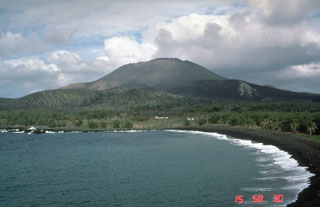Report on Pagan (United States) — June 1992
Bulletin of the Global Volcanism Network, vol. 17, no. 6 (June 1992)
Managing Editor: Lindsay McClelland.
Pagan (United States) Recent small ash eruption; long-period earthquakes and tremor; inflation
Please cite this report as:
Global Volcanism Program, 1992. Report on Pagan (United States) (McClelland, L., ed.). Bulletin of the Global Volcanism Network, 17:6. Smithsonian Institution. https://doi.org/10.5479/si.GVP.BGVN199206-284170
Pagan
United States
18.13°N, 145.8°E; summit elev. 570 m
All times are local (unless otherwise noted)
A six-member team of USGS volcanologists visited the Commonwealth of the Northern Mariana Islands 11-27 May 1992 at the request of the CNMI Office of Civil Defense. The team observed all of the islands in the chain N of Saipan, installed a new seismic station at the base of frequently active Pagan, remeasured existing EDM networks, mapped the geology of Alamagan, sampled fumaroles and hot springs, and collected rocks and charcoal for radiocarbon dating. No volcanoes in the chain erupted during the observation period.
Reports from brief visits to Pagan indicate that the most recent small ash eruption occurred on 13 April. Continuing seismicity was dominated by short bursts of long-period earthquakes and volcanic tremor. The highest measured steam temperature was 76°C; solfataras that are probably hotter are inaccessible deep within the crater. Episodic fuming, marked by periods of relatively high SO2 outgassing followed by quiescence, was observed continuously 13-21 May. EDM lines from the coast to reflectors on the flanks had shortened by as much as 11.3 cm since September 1990. These lines had shown no significant changes between 1983 and 1990, a period characterized by frequent small ash eruptions following the large Plinian eruption of 15 May 1981 (Banks and others, 1984). After the first remeasurement on 17 May, no large changes in line lengths were detected during the next 3 days.
The team collected three charcoal samples on Pagan. Two of the units to be dated are relatively old, and their ages should help to constrain the age of the caldera.
South Pagan . . . has several steaming fumaroles, but no temperatures were measured. No shallow earthquake swarms have been recorded since the installation of the seismic station in 1990.
Reference. Banks, N.G., Koyanagi, R.Y., Sinton, J.M., and Honma, K.T., 1984, The eruption of Mount Pagan volcano, Mariana Islands, 15 May 1981: JVGR, v. 22, p. 225-269.
Geological Summary. Pagan Island, the largest and one of the most active of the Mariana Islands volcanoes, consists of two stratovolcanoes connected by a narrow isthmus. Both North and South Pagan stratovolcanoes were constructed within calderas, 7 and 4 km in diameter, respectively. North Pagan at the NE end of the island rises above the flat floor of the northern caldera, which may have formed less than 1,000 years ago. South Pagan is a stratovolcano with an elongated summit containing four distinct craters. Almost all of the recorded eruptions, which date back to the 17th century, have originated from North Pagan. The largest eruption during historical time took place in 1981 and prompted the evacuation of the sparsely populated island.
Information Contacts: R. Moore, USGS; R. Koyanagi, M. Sako, and F. Trusdell, HVO.

